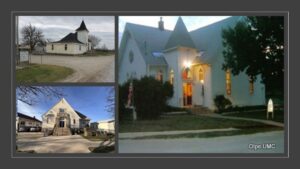Introduction:
Jurgen Moltmann’s assertion, “True hope is lived in the giving of oneself to the future of the hopeless…. Faith is manifested in love for those in need,”[1] resonates deeply amidst the challenges facing rural churches. The shrinking populations, increased poverty, and declining religious membership have profoundly impacted their mission of making disciples of Jesus Christ. Despite these obstacles, rural churches draw inspiration from Moltmann’s words, embodying true hope through their commitment to relational ministry, spiritual enrichment, and community outreach. Based on the insights gained from studying these three rural churches, I propose suggestions that, if implemented, could help other rural churches thrive in the face of declining membership.

Picture by Author: Ebenezer GMC-top Left; Madison GMC lower left and Olpe UMC – right
The project centers around three rural churches in Olpe and Madison, Kansas: The Olpe United Methodist Church, Ebenezer Global Methodist Church (Ebenezer United Methodist), and Madison Global Methodist Church (Madison United Methodist), nestled respectively in Lyon and Greenwood Counties. These three rural churches are predominantly Caucasian, with about 45% Seniors, 35% middle/young adults, and 20% youth. I was the first and only African Pastor assigned to this church in its 408 years of history.
The essence of this project lies in revealing the manifold challenges besieging rural churches, leading to a decline in membership. Concurrently, it seeks to unravel the tapestry of triumphs that have enabled select congregations to not only weather the storm but thrive and flourish against all odds. The three churches in the project will be addressed collectively as “rural churches” and, at times, individually mentioned because of specific ministry highlights that the author assisted in revising.
Rural churches remain steadfast in pursuing a flourishing future defined by sustained membership growth, a rich historical legacy, an influential presence, and unwavering community impact in the face of adversity. Through my project, I explore rural churches’ challenges and hurdles, including those contributing to membership decline. However, I also illuminate the triumphs and strategies that have enabled these rural churches to thrive against all odds.
Through Moltmann’s lens, we see that true hope is not merely an abstract concept but a lived reality embodied in the selfless dedication of rural churches to their communities. Through acts of love and service to those in need, their faith is made tangible, guiding them toward a future filled with hope and possibility.
Explanation of Project and Research Process:
At the heart of rural churches lies their fundamental mission of making disciples for Jesus Christ, which is essential for their growth and vitality. However, they face formidable challenges due to a significant decline in membership, including economic strains, an aging congregation, and competition from alternative leisure activities. As the newly appointed Pastor, I thoroughly assessed these challenges, recognizing the urgent need for refining programs and ministries to maintain relevance within the community.
The study employs a diverse array of research methodologies to explore the resilience of these rural churches amidst adversity. Qualitative research serves as the cornerstone, providing an exploratory and subjective perspective that facilitates a deeper understanding of the complex dynamics involved. Additionally, observations, interviews, surveys, and focus groups are integral tools utilized across all three rural churches. They offer invaluable insights into their thriving despite challenges and allow for a comprehensive examination of their resilience amidst adversity.
Findings:
A significant trend became apparent upon immersing myself in church and community life: while secular activities thrived, church attendance lagged. Subsequent interviews with church members and community individuals solidified this observation, highlighting the prioritization of secular engagements over religious commitments. Nevertheless, amid this prevailing trend, a steadfast group of faithful congregants persisted in their dedication to worship and community service, acting as beacons of resilience.
The issue of aging families relocating to be nearer to their children and grandchildren arose. Economic factors further compounded the situation, prompting individuals to seek employment opportunities in larger cities, resulting in a decline in the rural population.
However, despite these challenges, a core group of devoted congregants remained unwavering in their commitment to worship and community engagement, serving as pillars of resilience. To delve deeper into this resilience, follow-up surveys and focused group discussions unveiled underlying factors such as sincerely held religious beliefs, a strong sense of community, spiritual fulfillment, and a dedication to outreach programs.
Future Implications and Suggestions:
As the Pastor, I found these findings to be a catalyst for action. Recognizing the necessity for strategic intervention, I initiated a revitalization process guided by principles of adaptability and relevance. Through collaborative efforts, we set out to rejuvenate existing ministries and programs, infusing them with new perspectives and innovative approaches. Additionally, we placed a concerted emphasis on outreach initiatives aimed at engaging the broader community and fostering meaningful connections beyond the confines of our church walls.
Specific innovations were implemented to address the need for revitalization. For instance, we involved parents in the after-school program, “All God’s Children,” at Olpe United Methodist Church, inviting them to witness their children’s activities firsthand. We also advertised the Third Saturday Supper on local media platforms and introduced a monthly outdoor worship service at Madison Global Methodist Church to enhance community engagement. Community-focused events such as vacation Bible school at Madison and the annual fishing tournament at Ebenezer Global Methodist Church injected fresh perspectives into our outreach efforts. The men ministry at Madison and Ebenezer was revitalized getting the men to serve in the community.
These collaborative endeavors underscored the churches’ determination to remain relevant in a changing landscape. Their resilience serves as a testament to their commitment to community relevance and highlights the effectiveness of collaborative revitalization initiatives.
Insights from the Project
The study highlights rural churches’ unwavering commitment to making disciples for Jesus Christ. As a Pastor in this setting, I have grasped the delicate balance needed to lead while being part of the community. Patrick B. Reyes emphasizes this balance, stressing mastery and purposeful pursuit[2]. Through my experiences, I have learned the vital role of shepherding both church members and the broader community. By supporting initiatives like food drives and providing essentials for local children, rural churches showcase their relevance and compassion. This reaffirms their crucial role in spiritual growth and community support, ensuring their continued impact.
Conclusion:
The journey toward revitalization is an ongoing endeavor marked by resilience and unwavering determination. Through continuous assessment, adaptation, and community engagement, rural churches in Olpe and Madison are positioned to overcome the challenges of declining membership and emerge as vibrant hubs of spiritual growth and community enrichment. Donald McGavran emphasizes that “Carrying on the whole program of God in the world is the mission of the Church[3].” Guided by faith and fortified by collective determination, these rural churches remain steadfast in their commitment to the timeless mission of disciple-making as they navigate this journey of resilience knowing that God is faithful.
[1] Moltmann, Jürgen. 1977. The Church in the Power of the Spirit : A Contribution to Messianic Ecclesiology. 1st United States edition. New York: Harper & Row. 95
[2] Reyes, Patrick B. 2021. The Purpose Gap: Empowering Communities of Color to Find Meaning and Thrive. Louisville, Kentucky: Westminster John Knox Press. 96
[3] McGavran, Donald A. (Donald Anderson). 1970. Understanding Church Growth. Grand Rapids: Eerdmans. 354


